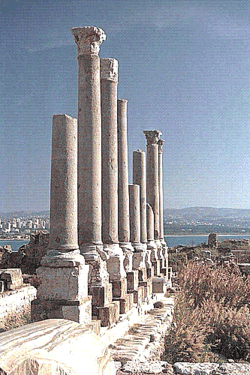Isaiah 23
| Isaiah 23 | |
|---|---|
 The Great Isaiah Scroll, the best preserved of the biblical scrolls found at Qumran from the second century BC, contains all the verses in this chapter. | |
| Book | Book of Isaiah |
| Bible part | Old Testament |
| Order in the Bible part | 23 |
| Category | Nevi'im |
Isaiah 23 is the twenty-third chapter of the Book of Isaiah in the Hebrew Bible or the Old Testament of the Christian Bible. This book contains the prophecies attributed to the prophet Isaiah, and is a part of the Book of the Prophets.[1][2] This chapter foretells the destruction of Tyre due to its pride, Isaiah 23:1-14; its rising again, Isaiah 23:15-17, and conversion to God, Isaiah 23:18.
Text

The ruins of Tyre

Map of ancient Tartessos (identified as Tarshish)
- The original text is written in Hebrew language.
- This chapter is divided into 18 verses.
Textual versions
Some most ancient manuscripts containing this chapter in Hebrew language:
- Masoretic Text (10th century)
- Dead Sea Scrolls: (2nd century BC) [3][4]
- 1QIsaa: complete
- 1QIsab: extant: verses 1‑5
- 4QIsaa (4Q55): extant: verses 1‑12
- 4QIsac (4Q57): extant: verses 8‑18
Ancient translations in Koine Greek:
- Septuagint (3rd century BC)
- Theodotion version (~AD 180)
Verse 1
- The burden of Tyre.
- Howl, ye ships of Tarshish; for it is laid waste, so that there is no house, no entering in:
- from the land of Chittim it is revealed to them.[5]
- "Tyre" (Hebrew: צֹ֑ר Tsor written צוֺר in 1 King 5:15; Greek: Τυρος, Tyros; Phoenician צר; Assyrian ‚urru, (also in Tel Amarna); Egyptian Da-(ï)ra, Da-ru.): famous Phoenician city, which in ancient time was built on a "rock" (the original meaning of its name) offshore in the Mediterranean Sea. The city was already prosperous in 14th century BC as a major trading port. It was strongly fortified but at the end was laid waste after conquered by Alexander the Great. The modern city is the continuation of ancient extension of the city in the mainland.[6][7]
- "Tarshish" (Hebrew: תרשיש Tar-shîsh): a faraway port, generally identified as "Tartessos" (Greek: Ταρτησσός) in Spain, located in the mouth of Guadalquivir river, where the Phoenicians are said to establish the first anchorage grounds and deal in precious metals. Other possibilities include: Tarsus in Cilicia, Tyrseni in Etruscan/Tuscany, or Carthage in North Africa.[8][9]
- "Chittim" (or "Kittim"; Hebrew: כתים Kit-tîm): "Citienses", "Cypriotes" or "Cyprians", a Phoenecian colony in Citium (=Kition), Cyprus. The term is also used in general for places beyond Cyprus, as far as Greece.[10][11]
See also
- Related Bible parts: 1 Kings 5, Jeremiah 47, Ezekiel 26, Joel 3, Amos 1
Notes and references
- ↑ J. D. Davis. 1960. A Dictionary of the Bible. Grand Rapids, Michigan: Baker Book House.
- ↑ Theodore Hiebert, et al. 1996. The New Interpreter's Bible: Volume VI. Nashville: Abingdon.
- ↑ Timothy A. J. Jull; Douglas J. Donahue; Magen Broshi; Emanuel Tov (1995). "Radiocarbon Dating of Scrolls and Linen Fragments from the Judean Desert". Radiocarbon. 37 (1): 14. Retrieved 26 November 2014.
- ↑ Ulrich 2010, p. 493-495.
- ↑ Isaiah 23:1
- ↑ Brown, 1994 & צֹר.
- ↑ Gesenius, 1979 & צֹר.
- ↑ Brown, 1994 & תרשיש.
- ↑ Gesenius, 1979 & תרשיש.
- ↑ Brown, 1994 & כתים.
- ↑ Gesenius, 1979 & כתים.
Bibliography
- Brown, Francis; Briggs, Charles A.; Driver, S. R. (1994). The Brown-Driver-Briggs Hebrew and English Lexicon (reprint ed.). Hendrickson Publishers. ISBN 978-1565632066.
- Gesenius, H. W. F. (1979). Gesenius' Hebrew and Chaldee Lexicon to the Old Testament Scriptures: Numerically Coded to Strong's Exhaustive Concordance, with an English Index. Translated by Tregelles, Samuel Prideaux (7th ed.). Baker Book House.
- Ulrich, Eugene, ed. (2010). The Biblical Qumran Scrolls: Transcriptions and Textual Variants. Brill.
External links
Jewish
Christian
This article is issued from
Wikipedia.
The text is licensed under Creative Commons - Attribution - Sharealike.
Additional terms may apply for the media files.